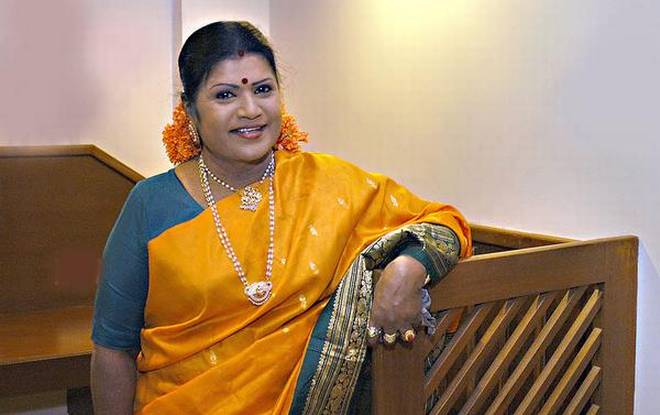LR Eswari dominated the South Indian film industry during the Sixties and Seventies. A phenomenal talent that she was, any kind of song just came to her
There’s something curiously common about several playback singers of yesteryear – most of them have had no formal training in music in their formative years. On listening to their singing, if one feels it is a phenomenon it is not an amplified statement. LR Eswari, the playback singer who was a rage in the South Indian film industry during the Sixties and Seventies, is the finest example of an unschooled genius. She was prodigious to say the least – her sophistication, versatility, effortlessness… would make one want to believe that there is something to music beyond the rigours of sadhana. Her exceptional voice range could manoeuvre complex ideas and a gamut of emotions at the speed of the mind – sensuous to spiritual, all at one go. The thought and its physical manifestation fused in Eswari’s music. In her, the song and the singer were not separate entities. Altering the very meaning of the creative process itself, in Eswari’s music, the melody began in the composer’s mind and ended in the singer’s articulation of it.
Let us take the song “Sityaako Sidkyaako” from the film, Veera Sankalpa (1962, music by Rajan-Nagendra). Operating within a folk framework, the song, in my opinion is among the most beautiful love songs. An extraordinary composition, the song has folk inflections and typical folk phrases; it is soft, breezy and melodious. What Eswari does to this song is fantastic – she doesn’t give it a monochromatic shade of love, but packs in all its shades so sensitively that you know that it is not an ordinary mind at work. A voice that has amazing throw and energy, becomes so tender in this song: there is the intensity of passionate love, an eternal promise and all this she conveys through intonations. There are two similar folk phrases in the song, “ha ha” at the end of the stanza and “oh hoi” at the end of the refrain “Sityaako Sidkyaako Nanna Jaana”. The former, she works on like a caress with a small silence, and the latter with a playful, folk abandon . With this Eswari unravels the drama of love like a seasoned actor. Next, when she sings the “Tandana tana” she heightens the energy in her voice celebrating the beauty of their feelings for each other. This one song can become a case study for the remarkable singer that she was. In fact, this folk abandon that was part of her sensibility, catapulted her into one of the finest singers of cabaret songs.
Lourde-Mary Rajeshwari, who later became LR Eswari, is a Roman Catholic from Tamil Nadu. Her mother Regina Mary Nirmala sang for chorus in films. As a child, she accompanied her mother to the studios, and soon became a chorus singer herself. But within no time, her potential was recognised and she became the main singer. As a 19-year-old, under KV Mahadevan’s direction, LR Eswari sang “Ivare Thaan Avarey”, and in no time became the favourite of all top music composers of her time.
Eswari sang plenty of songs for Kannada films, and each of them is a masterpiece, they were songs that nobody else could sing but her. “Suma Baaleye Premada Siriye” (Chandavalliya Thota, 1970) is in a way the opposite of “Sityaako Sidkyaako”. A waltz kind of song, it has a western approach (listen to the subtly jagged way in which “Bali saari begane baara” is composed). Eswari gives an authentic touch to the highs and lows in her sprightly demeanour. Each song that she has sung is distinct. “Rasika Rasika” (1970, Bhupathi Ranga) has a narrative that is entirely different from “Dooradinda Bandavare” (Taayi Karulu, 1962). “Dooradinda Bandantha”, rich and robust in its soundscape, was a typical R.D. Burman kind of song, “Bawaju Katti Nodu Baaro” (Sipayi Ramu,1972) was earthy folk, “Ayyayyo Halli Mukka” mocked the folk and had parts where it imitated the Japanese pentatonic, “Aasha Vilasi Ee roopa rashi” (Mallammana Pavada, 1969) was oozing sensuality… Eswari delivered each of these songs as is if she was native to them. Her high voltage, nasal rich voice had a sophisticated understanding which gave the songs a unique quality.
How does one explain Eshwari’s musical talent? Does one call it intuitive, a feeling-based perception? But can such feelings exist in the absence of observation of this world? So, observation and intuition are not necessarily counter to each other, and in her case, one was constantly informing the other, as also forming her music. They were not separate from each other, but supporting each other. Finally, whatever be the meaning of the song that Eswari renders, her notion of music is spiritual which is transferred to the experience of the listener.
If one considers her huge body of work across Telugu, Tamil, Kannada, Malyalam and Hindi, Eswari is perhaps among the most versatile singers India has produced. Her voice, her rendition, her range, equals the best. Yet, when we speak of versatility, why do we invariably speak only of Asha Bhosle and never of singers like Eswari? If S Janaki refused the Padmabhushan award conferred on her in 2013, she had a just case.
Inner Voice is a fortnightly column on film music
source: http://www.thehindu.com / The Hindu / Home> Entertainment> Movies / by Deepa Ganesh / March 21st, 2018
